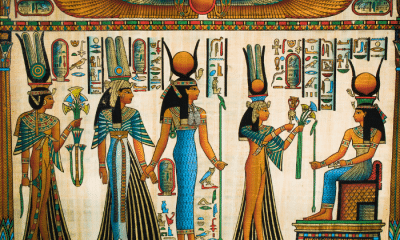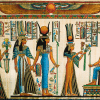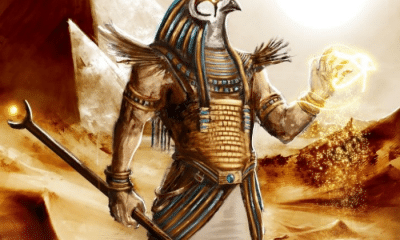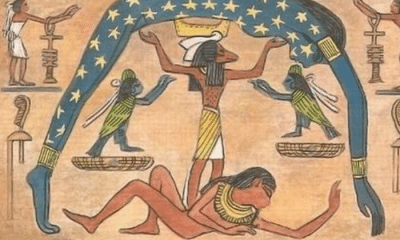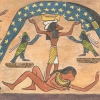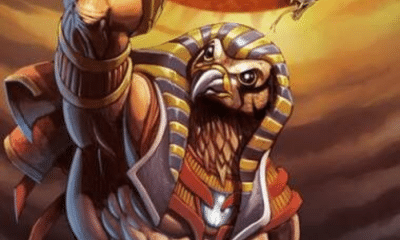Egyptian
Who Was Nephthys in Egyptian Mythology?
The realms of life and death were closely connected in Egyptian mythology, and nowhere was that more apparent than in the goddess Nephthys.
Nephthys is not one of the most well-known Egyptian deities today, but in the ancient world she was seen as a vital protectress.
She was most often associated with death, funerary rites, and mourning. To the people of ancient Egypt, however, this did not make her a malevolent figure.
Life, death, and rebirth were all closely connected concepts in Egyptian thought, so Nephthys often worked alongside her sister Isis. They both shared aspects of a life-giving mother goddess and complemented one another in their roles.
How exactly did the goddess of darkness also give life? Keep reading to find out!
Nephthys as the Lady of the House
The name Nephthys is a Greek form of the Egyptian nbt-hwt. Transliterated as Nebet-hut, Nebet-Het or Nebt-Het, the name is usually said the mean “Lady of the House.”
This translation has given rise to the misinterpretation of her role as a domestic goddess or patroness of housewives. In fact, the “house” referred to in her title is likely a house of the gods rather than of an individual.
This was probably a title rather than the goddess’s given name and referenced just one of her many functions.
Nephthys was likely associated with a specific aspect of temple ritual in the Egyptian religion.
The hieroglyphs that represented her combined the symbols for “lady” and “temple.” The symbol for the sacred enclosure of the temple was a house, thus leading to the misinterpretation of her title, while the symbol for “lady” that topped it was a basket.
Some historians believe that Nephthys and her sister Isis specifically represented the pylon, or monumental entryway, into the temple. This made her a goddess of liminal spaces and transition, a role made clear in her association with death and life.
The Companion of Set
Nephthys is traditionally considered to be the wife of the god Set. Most retellings of mythology show Set as a violent force representing the dangers of the desert, foreigners, and storms, but modern interpretations have brought that role into question.
Many Egyptologists now believe that Set appeared in two forms in ancient mythology. Nephthys was associated with the benevolent form of Set who partnered with Ra to destroy Apep, the serpent of chaos.
The marriage of Nephthys and Set is only recorded in Roman sources. Plutarch, writing thousands of years after the earliest Egyptian texts, was likely referencing a localized myth from the western edges of the Egyptian desert rather than conventional beliefs of the Nile Delta.
While few Egyptian sources link Nephthys and Set in any meaningful way, she was more closely linked with Anubis, the jackal-headed god of the Underworld.
According to Plutarch, Nephthys and Set were the parents of Anubis, although older sources name Bast as his mother and Osiris or Ra as his father.
Plutarch may have been influenced by the roles Nephthys and Anubis played in the mortuary practices of Egypt. Both deities had important connections to the Underworld and a major role in the practice of mummification.
Nephthys and Her Sister
While the identities of her husband and child can be debated, the relationship between Nephthys and her sister was much more clear.
Nephthys was the sister of Isis. While the other goddess is more well-known today, in ancient Egypt they served in complementary roles.
Both Isis and Nephthys were associated with death and the journal of the soul to the Underworld.
When Osiris, Isis’s husband and brother, was murdered the two goddesses worked together to gather his remains. Here, they both played a role in death but took on different aspects.
Isis resurrected her murdered spouse and conceived his son Horus, making her a goddess of life and birth. Nephthys served as her brother’s chief mourner, making her a goddess funerary rites and death.
The two were intrinsically linked to both death and life. The Pyramid Texts, the oldest known funerary and religious texts from ancient Egypt, instructed the souls of the dead to follow both Nephthys and Isis on their journey:
Ascend and descend; descend with Nephthys, sink into darkness with the Night-bark. Ascend and descend; ascend with Isis, rise with the Day-bark.
— Pyramid Text utterance 222, line 210 (trans. Faulkner)
Nephthys may have been the darker counterpart of Isis, but in Egyptian thought this did not make her an evil or morbid character.
In Egyptian religion, death was considered to be the end of one life and the beginning of another. Nephthys, who knew the spells and rituals needed to pass safely into the afterlife, was not a destructive goddess but one who protected souls in their birth in the next world.
Because their natures were similar and complemented one another, Nephthys and her sister often shared roles. Both were revered in some aspects of both birth and death and goddesses who protected the transition of the soul from one state to the next.
Symbols of the Lady
Egyptian art was famously standardized and formulaic. Artistic representation was so strictly regulated that, with few exceptions, Egyptian art was virtually unchanged over the course of several thousand years.
This meant that the Egyptian gods, arguably more than those of any other religion, were shown with a consistently recognizable set of attributes and symbols. Images of Nephthys and the other gods from the First Dynasty, roughly three thousand years BC would be almost identical to those from the Thirtieth.
Nephthys was depicted in Egyptian art as a young woman. Her identifying symbols included:
- Her hieroglyph: Nephthys was crowned by the “temple” and “lady” symbols even in sculpture.
- Kite: In certain contexts, such as on canopic jars, Nephthys was symbolized by either a bird of prey or a woman with falcon wings. The cries of a kite were said to remind people of the cries of mourning women at a funeral.
- Isis: Nephthys was most often shown as part of a group of deities rather than as an independent agent. Most often she was alongside Isis, sometimes accompanied by Osiris, Anubis, Horus, or Min.
- Ankh: Nephthys was one of many deities who often carried the symbol of life in one hand.
The inclusion of the ankh among the symbols of Nephthys referenced for than her divinity. It also drew attention to the special role she was believed to hold among the rulers of Egypt.
The Pharaohs’ Relationship to Nephthys
Beginning in the 13th century BC, the people of Egypt referred to their kings as pharaohs. The Pharaoh held an important position not only within Egyptian politics, but within its religion as well.
The Pharaoh was identified with the god Horus, either as his mortal incarnation or his representative on earth. Throughout much of Egyptian history, the Pharoah was believed to rule as a living god.
The Pharaoh was also associated with Osiris, who wore the crown of Upper Egypt and the pharaonic beard. He was the father of Horus and thus, symbolically if not literally, the father of the Pharaoh.
Osiris was particularly important in the cult of the Pharaoh because he, like them, had been restored to kingship after his death. The death and resurrection myth of Osiris provided the foundation for the belief that the Pharaoh would be elevated to divinity after his own death.
Isis, Osiris’s wife and sister, had enabled his second birth. Both she and Nephthys, however, played an important role in the birth of Horus.
Isis was described as the birth mother of Horus, but Nephthys was called the nurse mother of her nephew. While Isis had initially given life, Nephthys served as wet-nurse and thus nourished the god in his youth.
This relationship to the goddess sisters was continued in Horus’s mortal form, the Pharaoh. Isis was the mother of the king, but Nephthys was seen as his nourisher and protector.
Nephthys was a second mother to the king, but she could also be a fierce protector. Demons were said to tremble in fear of her and she could drive away the Pharaoh’s foes with fiery breath and potent magic.
Her role, however, was not to nourish and protect the Pharaoh for his role as king of Egypt. Her association with death continued and she was thought to give him strength throughout his mortal life to prepare him for his passage through the Underworld and ascent to godhood.
The Helpful Goddess
Nephthys was widely viewed as a goddess who could be helpful and protective, particularly to the Pharaoh. Her help at times took on rather surprising forms.
As a goddess of darkness, for example, she helped the Pharaoh to see by moonlight and navigate through the night. This was not only practical, but also helped the king to see the hidden truths of the darkness and, thus, the Underworld.
At Heliopolis she was probably considered to be the protectress of the mythological Bennu bird. An independent part of Ra’s soul, the bird helped in the creation of the world and represented rebirth and resurrection.
Along with Isis and other goddesses she was also a protector of women in childbirth. In one tale she, her sister, and two other goddesses disguised themselves as dancers to aid in the birth of four human boys who would grow up to be famous warriors and priests.
Perhaps most surprisingly, she was also considered a goddess of revelry. She was particularly associated with beer.
In several relief carvings, Nephthys was shown receiving offerings of beer from the Pharaoh. She then returned the drinks to him, allowing him to enjoy his inebriation without ever suffering from a hangover.
Of course, the final protective role of Nephthys was as a psychopomp. While guiding the dead she could scare away the demons that threatened them and tell them the secret spells and paths to follow in order to find their way to the next life.
Nephthys as a Goddess of Life and Death
The name Nephthys comes from an Egyptian title that loosely meant “Lady of the House.” Rather than a domestic goddess, however, Nephthys was the lady of the temple.
More specifically, she was a goddess of liminal spaces. In the temple she represented the passage through the doorway from the material world to the spiritual; elsewhere she was a goddess who crossed the barriers between life and death.
In this, she was the close companion of her sister, Isis. The two were seen as complementary goddesses of life, death, and rebirth.
One of her most important roles was as a psychopomp. Nephthys was one of the principal deities who safely guided the dead through the levels of the Underworld.
She was also a patroness of the Pharaoh. As the mortal form of Horus, the Pharaoh was born to Isis but nursed and protected by Nephthys.


